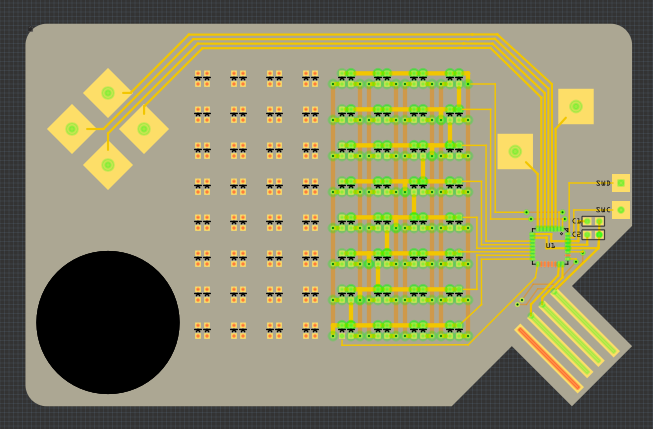After designing a cheaper version of the #PewPew FeatherWing recently, I started thinking: what if instead of using a separate chip for driving the LED matrix, I used the free pins on the MCU? And instead of buttons use touch pads? And instead of a USB port use the shape of the PCB? I could get the BOM literally to a few parts!
One problem with that: I would need 24 pins to drive the bi-color matrix. Sure, I could add shift registers and decades and whatnot, but then I'm back to using additional chips, and with the price of the HT16K33, I may just as well use that. But what if I could use fewer pins? Are there tricks for that?
With charlieplexing I could drive a 16×8 matrix with as few as 12 pins (the formula is n²-n, which for 12 gives me 132 LEDs, four more than my required 128). But you can't charlieplex matrices with common cathodes. Well, you can, but that's not useful for square matrices. But what if I made my own bi-color matrix on the PCB? You can get 0603 bi-color LEDs cheaply — in fact cheaper than the equivalent matrix. Soldering them is a lot of work by hand, but if I got it fabricated the pick-and-place machine does all the work anyways. And it would then be flat. Like a business card.
Wait a minute...
With so few parts it could actually be cheap enough to use as a business card!
So I made this mockup:

The big black hole is for a CR2032 battery — it will be sunken into the PCB, to keep the thickness at a minimum.
I even started routing the matrix — for now I have routed 8×8 LEDs with 9 pins used, and 7 pins free. Now I have two options: route the other half the same way, using the remaining 7 free pins, and the two debugging pins (possibly with some jumpers to disconnect them for debugging), or redo the whole thing as a 12×11 matrix using only 12 pins, and then rearrange the LEDs back to 16×8. Of course the second option would be much better, but I'm not sure I have the stamina for that. If I go for the 2×8×8 approach, I might also separate the two colors — we will see how it goes.
 deʃhipu
deʃhipu
Discussions
Become a Hackaday.io Member
Create an account to leave a comment. Already have an account? Log In.
also, charlie plexing formula is n*(n-1) :)
Are you sure? yes | no
which, if you do the multiplication, comes out to n²-n
Are you sure? yes | no
crap, I somehow got 133 with the calculator earlier :D totally makes sense and I apologise :)
Are you sure? yes | no
how thin does the pcb have to be, to fit in a usb cable?
Are you sure? yes | no
according to the USB standard, it should be 2.4mm thick — I will use as thick PCB as I can, and glue a rectangle of FR4 under the plug to add the missing thickness
Are you sure? yes | no
did you cheat by removing the screenshot of the USB micro version and replaced that with a classic USB A plug?
Are you sure? yes | no
Ah, the micro version would have to be much thinner — I think something around 0.6mm? I had it there briefly, but I decided that if I'm making workshops with this (which ultimately is the goal), then I don't want to muck about with additional USB cables for everyone. So an USB A plug makes more sense.
Are you sure? yes | no